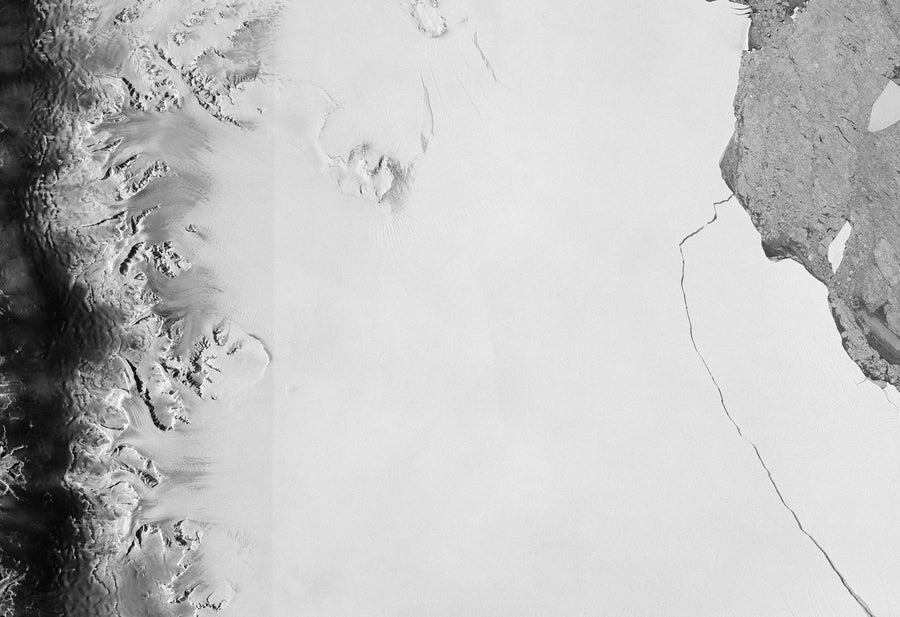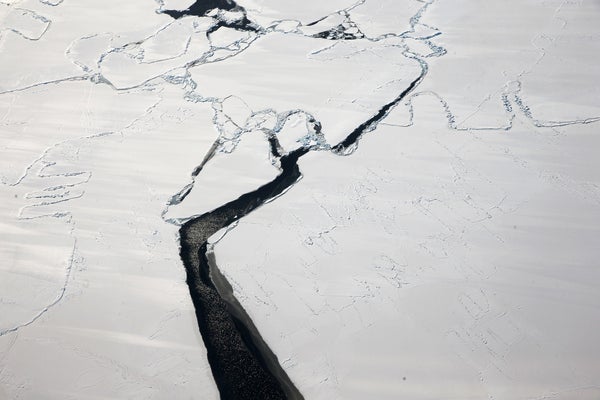Our fate is tied to a frozen desert at the bottom of the world. Should Antarctica's ice sheets dissolve, sea levels would rise dramatically—enough to flood the world's great coastal megalopolises from New York to Shanghai and push millions of people inland. But determining just how the vast and frigid continent is currently responding to a warming world has been a challenge. In West Antarctica the story is relatively clear. The floating platforms of ice that ring the coast are thinning, glaciers are surging toward the sea, meltwater is flowing across the surface, fast-growing moss is turning the once shimmering landscape green and a massive iceberg the size of Delaware broke off into the ocean in July of 2017. But in East Antarctica, where rising temperatures have caused increased humidity and thus more snowfall, the story takes an unexpected turn.
Most scientists agree that East Antarctica—unlike its western counterpart—is gaining mass in the form of snowfall or ice, or both. But how much? And is it enough to counterbalance West Antarctica's accelerating losses? A study published in Geophysical Research Letters in May 2017 by Alba Martin-Español of the University of Bristol in England and his colleagues suggests the gains in East Antarctica are so small that the continent is losing mass overall. This is just one in a long line of studies that disagree with rather controversial findings published in 2015 in the Journal of Glaciology, which suggested that Antarctica is gaining mass. That study sparked a dizzying debate—but one that will ultimately help glaciologists grasp just what is happening in East Antarctica and push scientists to consider how to handle contentious results in a warming world.
There is no doubt that the 2015 study, led by Jay Zwally, a glaciologist at NASA's Goddard Space Flight Center, flew in the face of previous research and even assertions made by the United Nations Intergovernmental Panel on Climate Change (IPCC). Zwally's study remains the only one to firmly conclude that Antarctica is growing. “That in itself doesn't mean something is wrong” with the result, says Jonathan Bamber, a glaciologist at Bristol, who co-authored the recent paper led by Martin-Español. Nevertheless, Bamber and many others agree the dominant consensus should still prevail—and that might be especially true in a field as highly politicized as climate change.
On supporting science journalism
If you're enjoying this article, consider supporting our award-winning journalism by subscribing. By purchasing a subscription you are helping to ensure the future of impactful stories about the discoveries and ideas shaping our world today.

Chunk of ice more than twice the size of Luxembourg broke off the Larsen C ice shelf in July 2017, spawning one of the largest icebergs on record. Credit: ESA, Containing Copernicus Sentinel Data from 2017
Zwally's results spread like wildfire across many conservative news outlets—including Fox News, Breitbart News and The Daily Express—which hailed it as another sign that the dangers of climate change have been exaggerated. Although climate scientists often see such news stories, they still worry about the dangers these might cause in today's political climate. That is why Theodore Scambos, a senior research scientist at the National Snow and Ice Data Center, decided to take matters into his own hands. He had just boarded a flight to attend a meeting of the American Polar Society when he overheard a neighboring passenger claim that Antarctica was gaining mass. “I thought, ‘Well, that's it—we have to say something because it's not,’” he recalls.
So Scambos and his Goddard colleague Christopher Shuman wrote a rebuttal to Zwally's paper. Using NASA and European Space Agency satellites, the 2015 study had measured the changing height of the ice sheet and determined that East Antarctica was ballooning upward by roughly 1.59 centimeters a year (at least from 1992 to 2001 and from 2003 to 2008). Although many agree East Antarctica is rising, Scambos and Shuman think the rate is much lower—and that the discrepancy arose from Zwally's technique. The satellites in his study fire lasers toward Earth. The beams reflect back at the satellite, allowing scientists to calculate the surface ice's height. But this technique is not perfect, and the beams require careful calibration using a flat, unchanging “reference surface.” For this, most scientists use well-understood regions on the ice sheet itself. But Zwally and his team used stretches of the Southern Ocean that are exposed between cracks in the ice, and Scambos worries that these pools are not as still as they seem. He argues that such surfaces can easily form a new layer of ice or even frost flowers—rare (and gorgeous) ice crystals that grow upward from the sea. This would make the reference surface move, an effect that could interfere with the data.
Even if other scientists could accept Zwally's measurements of ice sheet inflation, they would quickly run into what many would see as a second hiccup in his study. To translate the change in height (and therefore volume) into a change in mass, scientists must assume a certain density. The question is: Just what is rising? Is it snow or ice? Zwally contends it is ice, and argues that at the end of the last ice age, roughly 10,000 years ago, the amount of snowfall doubled. This would mean that it has been compacting into solid ice for millennia and continues to do so today. Most other scientists, however, do not agree that this is still going on now and argue that any increase in the ice sheet's height is from added snowfall alone. In this case, the density of snow would be the right number to use. The difference is critical: a rise of one centimeter of snow across all of East Antarctica is the equivalent of 35 billion metric tons, but a rise of one centimeter of ice is the equivalent of 92 billion metric tons. Using the latter (plus a huge rise in the height of the ice sheet), Zwally's study finds that East Antarctica has gained roughly 147 billion metric tons a year.
But other studies disagree. Take the latest study published by Martin-Español, Bamber and their colleagues, which incorporates a different approach that does not require a numerical density model. Instead the team used data from a satellite called the Gravity Recovery and Climate Experiment (GRACE), which measures changes in Earth's gravitational field that are caused by changes in mass. They found that the gains in East Antarctica were about three times smaller than those suggested in Zwally's 2015 study. From 2003 to 2013 they measured an annual rise of roughly five millimeters, which they think is equivalent to 57 billion metric tons of fresh new snow every year. Because this gain is lower than the losses occurring in West Antarctica, they conclude the entire continent has made a net contribution to sea-level rise. “It's the kind of integrated study that we absolutely need to understand how the planet works and how it's changing,” says Robin Bell, a polar scientist at the Lamont-Doherty Earth Observatory at Columbia University.

Sea ice in McMurdo Sound, Antarctica, splits to reveal long passages that marine life can travel through. Credit: Norbert Wu Getty Images
Zwally, however, remains confident in his numbers. “It's definitely a bit of a contentious issue—not just polite conversation,” says Scambos, who continues to worry about the harm a dispute like this can do in a time when many science fields are increasingly subject to political polarization. To see causes for concern, one need only look as far as the infamous—and now retracted—paper published in 1998 that suggested the combined measles, mumps and rubella vaccine in children raised the chances for autism. Despite the retraction, the paper helped to fuel a worldwide fear of vaccines and continues to be referenced to this day. Similarly, Zwally's 2015 study—though scientifically sound—is an outlier cherry-picked by conservative news outlets to advance their denialist positions. In summer of 2017 Prison Planet, one of far-right radio host Alex Jones's Web sites, offered it as evidence that President Donald Trump made the correct decision in leaving the Paris agreement on fighting climate change. As such, Scambos thinks Zwally's paper “has been a real disservice to the science community.”
Perhaps the light at the end of the tunnel is that the debate has sparked conversation about how to handle such controversial studies. “By and large, the primary responsibility of the scientists is to present what they believe to be the most reliable and accurate science,” Bamber says. “How the media interprets that can often be out of [scientists'] control.... Having said that, I think we also have a responsibility to ensure that we communicate the messages in a clear and unambiguous way.” Zwally notes that he was vigilant about this in 2015. “When our paper came out, I was very careful to emphasize that this is in no way contradictory to the findings of the IPCC report or conclusions that climate change is a serious problem that we need to do something about,” he says. He was referring to the panel's 2013 report, which stated not only that Antarctica was losing mass but that the process was accelerating. Zwally knew Antarctica would contribute to sea-level rise in a warming world but simply did not agree that the effect had already kicked in. He was therefore less than thrilled to see the conservative media having a field day with his study.
Still, many argue the controversial results are a natural process within scientific study. If you shine a spotlight on almost any corner in science, you are bound to find disagreement. “That's the way that science has moved on since Archimedes, since Isaac Newton, since [Johannes] Kepler,” says Andrew Shepherd, a polar scientist at the University of Leeds in England. “Everybody has a difference of opinion, and if they didn't—if everybody believed what had gone before—we wouldn't move forward.”
At the end of the day many agree that Zwally's study—albeit an outlier—has pushed the science forward. It sparked reactions in the community, from rebuttals to new papers, which will likely help glaciologists across the globe eventually pin down just what is happening in East Antarctica. Shepherd, for example, is currently working on a review that will reconcile roughly 50 findings from the many techniques that have measured the ice mass balance, and will hopefully settle on an accurate average. That said, it might be a moot point. Zwally's study team claimed that if mass losses in West Antarctica continued to increase, it would only be a few decades before they overtook the gains in the east. Also, the team has additional, unpublished data showing the mass losses in West Antarctica have not only increased, but have tripled—at least from 2009 to 2012. Early data show 2016 might have been the tipping point at which losses in West Antarctica became so great that they equaled those gains in East Antarctica. That means Zwally's results might already be in agreement with others on the key point: this frigid land—one that holds the fate of much of humanity—is melting.

